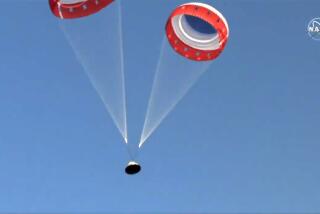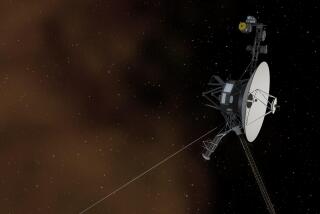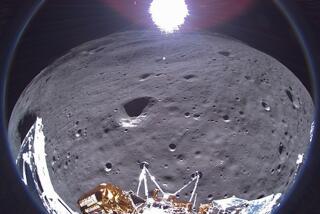Mars landing: Nervous, excited NASA prepares for text from space

- Share via
On the eve of the landing of the Curiosity rover on Mars, scientists have laid out some of the crunch time’s key moments. According to Los Angeles Times reporters at NASA’s Jet Propulsion Laboratory in La Cañada-Flintridge, the best-case scenario would have scientists high-fiving at 10:31 or 10:32 p.m. Pacific time Sunday.
That’s when scientists should receive what amounts to a text message from space.
Scientists are counting on the Odyssey orbiter -- which threw scientists for a bit of a loop several weeks ago when it experienced a glitch -- to relay data back to Earth telling them where Curiosity is, within a kilometer or two, and how hard it landed.
But even before that, there could be clues of good progress. At about 10:14 p.m., Mission Control should receive confirmation that the cruise stage of the spacecraft carrying the rover has separated. A message could arrive at 10:24 p.m. that Curiosity has entered the Martian atmosphere – when the clock on the “seven minutes of terror” begins ticking.
PHOTOS: A rover called Curiosity
Odyssey, one of the robotic spacecrafts that orbit Mars, had problems in early June with an instrument used to orient the satellite. NASA made one attempt to re-sync Odyssey, which failed, according to sources at the time.
But deputy project director Ashwin Vasavada told The Times on Saturday afternoon that Odyssey is back in sync.
Timely information from the orbiter is indeed the best-case scenario, Vasavada said by email -- “assuming the communications link works as we expect.”
If that link fails, and Odyssey is unable to relay signals telling of Curiosity’s fate, information on whether the rover lived or died will not come until about two hours later. Scientists expect to know Sunday in advance of the landing, however, whether Odyssey will be unavailable to help.
INTERACTIVE: From liftoff to landing
Over the last few days, scientists on the Mars Science Laboratory team have been spending a chunk of time looking beyond the much-talked-about landing of the rover.
“The rover operations and science teams have been busy this week finalizing the plans for the first few weeks on Mars,” Vasavada said Friday.
Vasavada said scientists at JPL would be “hovering over checklists and scripts in the next weeks, before it becomes more of a free-form process, driven by what Mars puts in front of us and what discoveries we’re making.”
“Those first critical weeks are highly scripted,” he said, “so that we carefully check out every inch of the rover and its payload before heading off to explore Gale Crater.”
Curiosity is set to land near Gale, a great place for delving into the possibility that Mars once had the water to potentially support life. There’s a mound at the crater that Vasavada, in an earlier interview, likened to “a book that has chapters from all the major parts of Mars history.”
Vasavada admitted to a sense of disbelief at this point in the mission.
“We’ve actually run the mission at Mars many times using our spare rover at JPL,” he said. “I’ve become so used to these rehearsals, I have to keep reminding myself that all the motions we’re going through this week are the real thing! When we get that first picture of our wheels on Mars, there won’t be any doubt.”
ALSO:
Mars exploration: Built on a good amount of failure
Right about now, at least one NASA engineer is ‘sweating blood’
One fun job: Gremlin for Curiosity mission; his job was to mess things up
Join Amy Hubbard on Google+ and Twitter.
More to Read
Sign up for Essential California
The most important California stories and recommendations in your inbox every morning.
You may occasionally receive promotional content from the Los Angeles Times.










